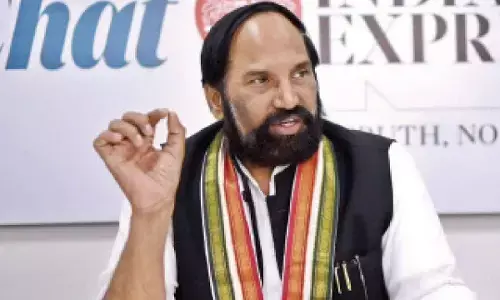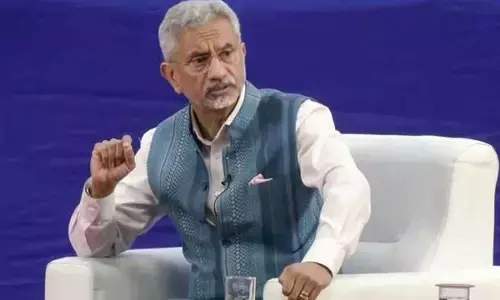Devil in the deep sea

The name USS “Diablo” doesn’t ring a bell. Suffice it would be to know that the meaning of this Spanish word is Devil, and it was the original name of the PNS Ghazi, that gave jitters to Indian Navy, since it has stalked, right from the 1965 war, the Indian Aircraft carrier INS Vikrant, as Pakistan Navy was well aware that without the mighty warrior at sea, India’s naval might would considerably b
The film ‘Ghazi Attack’ has brought forth an incident that has been resigned to the pages of history in what can be termed as a technically well-made film. However, it is fraught with avoidable errors, says bi-lingual poet, critic, translator and columnist, and a resident of Visakhapatnam, Rama Teertha
The name USS “Diablo” doesn’t ring a bell. Suffice it would be to know that the meaning of this Spanish word is Devil, and it was the original name of the PNS Ghazi, that gave jitters to Indian Navy, since it has stalked, right from the 1965 war, the Indian Aircraft carrier INS Vikrant, as Pakistan Navy was well aware that without the mighty warrior at sea, India’s naval might would considerably be weakened.
Vikrant too dodged many times, and remained elusive from the south East Asia’s first submarine with such power and prowess. In that way, both the formidable powers of South East Asia were differently empowered in the race for regional importance.
After WW II, and emergence of many independent nations from the colonial yoke, the world has travelled quarter a century, and both Pakistan, the then geographically located on both the west and east sides of India, and India itself positioned with a large swath of land in between, made both the nations, also developing countries with a freedom gained only twenty four years back, enemies at war.
Call it an accidental explosion, as maintained by Pakistan, or take it as a shining example of naval strategies adapted by Indian Navy, the loss of Ghazi, near the coast of Visakhapatnam, has in one way started the war between both the belligerent nations. Prime Minister Indira Gandhi, then also a key person in the Non-aligned Movement, displayed remarkable decision making character, and only waited for the other side to attack first. Having received such confirmation, while she was addressing a refugees camp near the border, she lead the nation from the front, and her collaboration and armed cooperation with East Bengali people and armed forces, gave the world, the first independent nation, whose aspirations to be independent took shape only post 1950s.
Indira Gandhi’s leadership and valour in the face of gigantic adversity is something to be compared with that of medieval queens and princesses of India and elsewhere, who fought for human freedom and dignity. She snubbed the then Secretary of State Henry Kissinger, when he did not assure of positive cooperation to end the East Pakistan stalemate - she at that breakfast meeting, very confidently sounded off, by pointing at Sam Manek Shaw, who was also at the breakfast table in full uniform upon invitation by Madam Gandhi - in case both the US President and Secretary of State fail to address the situation, then she would get the needful done by the military genius of Manekshaw.
Well, Kissinger did not expect such a turn, and at that time, US as a policy was intervening in many developing countries’ internal affairs, and in this case was extending all support to Pakistan, to continue with the policy of retaining the Eastern flank of it by forced annexation, and if necessary by implementing a bloodbath and pogrom against Hindus, and Bengali Muslims.
The loss of human life ran into millions, and by the end of December, 1971, India has emerged as the first Asian nation to support the genuine aspirations of people to gain the status of a Nation. Bhutan became the first country to grant recognition to the nascent country of Bangladesh.
The war had many fronts and battles were fought, on land, sea and in air. Much to the frustration of USA, and England, the regional cooperation between India and USSR reached a new high when the soviet naval might successfully stalled the ominous advances of seventh fleet of America and HMS Eagle, warship of UK, which had clear orders to go ahead with armed engagement with Indian naval forces.
Recently, a half throttled attempt was made by aspirant young Director Sankalp Reddy, though limited to Ghazi incident, which leaves professional treatment of the subject much behind. The production team is so irresponsible that while insulating themselves with standard disclaimers, they have used the name Ghazi, Eastern Naval Command, etc, and to the utter shock and disbelief, filmed an incident where PNS Ghazi, well into Indian waters on the Eastern seaboard, has fired a torpedo and sunk an Indian merchant vessel.
There was no such incident, and for that matter any navy of the World would refrain from such war crime. The filming reminded us of the Hollywood film, ‘Crimson Tide’, and reduced the story line to a one to one battle between two submarines; yet again a historical inconsistency. It was INS Rajput, and the mine charges fired by the warship that have caused the destruction, in the dead night at 00.15 hours of December 3, 1971, and the torpedo strike left tremors in the coastal residences, on the shore.
As the inspiring saga unfolded at many fronts and planes, coming away some fifty years from the conflict that led to the birth of a nation; there is every need to study the role of players direct and indirect. While UK in Europe and USA rallied adamantly with Pakistan, which was carrying out genocide on the Eastern side, it was the French Minister of Culture André Malraux, who very euphorically stated that he vows to fight alongside the Bangaldeshi forces, to ensure their freedom.
Such was the division of powers then. Indian engagement in this is beyond dismembering a neighbouring nation, since it is Yahya Khan, the then President of military head of Pakistan and his jingoistic team that has started in this dismemberment. India had seen it through, with the self-serving sacrifice of many East Bengalis.
Hence, making movies on such epochal flow of events requires a serious dedication and innovative cinematic genius, which is found singularly lacking in this less than mediocre flick that is now making rounds. Changing the story line thereby unnecessarily blacking out the significance of INS Vikrant, and completely ignoring the art of deception so carefully planned and executed by the ENC, and by the richly decorated, the then Vice -Admiral N Krishnan, further bringing in a East Pakistani woman into the story in clueless manner as to what to do with the character, heroics beyond naval discipline, non-standard sea burial to the Captain of the S-21, and the script galore with many technical and commonsense errors, can only be congratulated for the effort they have put in.
Further, the so called Ghazi attack that centers its attention on Visakhapatnam port, did not use the code word Pakistan Navy devised for Visakhapatnam at all in the movie. Evidently, that is the level of background research, and quality of story board discussion the production team had undergone. Well, the name, the Pakistan Navy had used for Visakhapatnam is ‘Zone Victor’.
By providence, or quite unknowingly, even our enemy has designated the city of destiny, as Zone Victor, and the history produced a result where the city of Visakhapatnam, has indeed emerged a Victory Zone.















